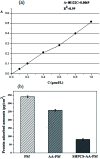Surface hemocompatible modification of polysulfone membrane via covalently grafting acrylic acid and sulfonated hydroxypropyl chitosan
- PMID: 35517280
- PMCID: PMC9062722
- DOI: 10.1039/c8ra10573a
Surface hemocompatible modification of polysulfone membrane via covalently grafting acrylic acid and sulfonated hydroxypropyl chitosan
Abstract
In this study, acrylic acid (AA) and sulfonated hydroxypropyl chitosan (SHPCS) were covalently grafted on the PSf membrane surface to improve its hemocompatibility. First, the modified AA-PSf membrane was obtained through the Friedel-Craft reaction between acrylic acid and the PSf membrane surface. Then, the modified SHPCS-AA-PSf membrane was prepared by grafting SHPCS onto the AA-PSf membrane surface via the dehydration acylation of the carboxyl group of the AA-PSf membrane with the amino group of SHPCS. ATR-FTIR and XPS measurements confirmed that the -COOH group and SHPCS were successfully grafted onto the surface of the PSf membrane. The modified PSf membranes showed suppressed platelet adhesion and lower protein adsorption (161 μg cm-2) compared with the pristine PSf membrane (341 μg cm-2). Hemocompatibility testing showed that modified membrane materials had a prolonged clotting time, plasma recalcification time (PRT), activated partial thromboplastin time (APTT), thrombin time (TT), and prothrombin time (PT). All of these results indicated that the surface modification of the PSf membrane with acrylic acid and SHPCS had good hemocompatibility and anticoagulant property.
This journal is © The Royal Society of Chemistry.
Conflict of interest statement
The authors declare no conflicts of interest.
Figures










Similar articles
-
Improving Hemocompatibility of Polysulfone Membrane by UV-Assisted Grafting of Sulfonated Chitosan.Polymers (Basel). 2024 May 31;16(11):1555. doi: 10.3390/polym16111555. Polymers (Basel). 2024. PMID: 38891507 Free PMC article.
-
The hemocompatibility of the modified polysulfone membrane with 4-(chloromethyl)benzoic acid and sulfonated hydroxypropyl chitosan.Colloids Surf B Biointerfaces. 2020 Apr;188:110769. doi: 10.1016/j.colsurfb.2019.110769. Epub 2020 Jan 2. Colloids Surf B Biointerfaces. 2020. PMID: 31918157
-
A novel kind of polysulfone material with excellent biocompatibility modified by the sulfonated hydroxypropyl chitosan.Mater Sci Eng C Mater Biol Appl. 2017 Oct 1;79:570-580. doi: 10.1016/j.msec.2017.05.103. Epub 2017 May 16. Mater Sci Eng C Mater Biol Appl. 2017. PMID: 28629055
-
Enhanced hydrophilicity and anticoagulation of polysulfone materials modified via dihydroxypropyl, sulfonic groups and chitosan.Colloids Surf B Biointerfaces. 2022 Feb;210:112243. doi: 10.1016/j.colsurfb.2021.112243. Epub 2021 Nov 27. Colloids Surf B Biointerfaces. 2022. PMID: 34861540
-
Preparation of modified polysulfone material decorated by sulfonated citric chitosan for haemodialysis and its haemocompatibility.R Soc Open Sci. 2021 Sep 8;8(9):210462. doi: 10.1098/rsos.210462. eCollection 2021 Sep. R Soc Open Sci. 2021. PMID: 34540249 Free PMC article.
Cited by
-
Functionalized Hemodialysis Polysulfone Membranes with Improved Hemocompatibility.Polymers (Basel). 2022 Mar 11;14(6):1130. doi: 10.3390/polym14061130. Polymers (Basel). 2022. PMID: 35335460 Free PMC article. Review.
-
Assessment of sulfonated homo and co-polyimides incorporated polysulfone ultrafiltration blend membranes for effective removal of heavy metals and proteins.Sci Rep. 2020 Apr 27;10(1):7049. doi: 10.1038/s41598-020-63736-8. Sci Rep. 2020. PMID: 32341422 Free PMC article.
-
Simulation-based assessment of zwitterionic pendant group variations on the hemocompatibility of polyethersulfone membranes.Funct Compos Mater. 2024;5(1):12. doi: 10.1186/s42252-024-00062-6. Epub 2024 Sep 11. Funct Compos Mater. 2024. PMID: 39399384 Free PMC article.
-
Improving Hemocompatibility of Polysulfone Membrane by UV-Assisted Grafting of Sulfonated Chitosan.Polymers (Basel). 2024 May 31;16(11):1555. doi: 10.3390/polym16111555. Polymers (Basel). 2024. PMID: 38891507 Free PMC article.
-
A Novel Generation of Polysulfone/Crown Ether-Functionalized Reduced Graphene Oxide Membranes with Potential Applications in Hemodialysis.Polymers (Basel). 2021 Dec 31;14(1):148. doi: 10.3390/polym14010148. Polymers (Basel). 2021. PMID: 35012170 Free PMC article.
References
-
- Zhao C. et al., Modification of polyethersulfone membranes-A review of methods. Prog. Mater. Sci. 2013;58(1):76–150. doi: 10.1016/j.pmatsci.2012.07.002. - DOI
-
- Bowry S. K. Gatti E. Vienken J. Contribution of Polysulfone Membranes to the Success of Convective Dialysis Therapies. Contrib. Nephrol. 2011;173(173):110–118. - PubMed
-
- Senthilkumar S. et al., Preparation, Characterization, and Performance Evaluation of Poly(ether-imide) Incorporated Cellulose Acetate Ultrafiltration Membrane for Hemodialysis. Sep. Sci. Technol. 2013;48(1):66–75. doi: 10.1080/01496395.2012.674603. - DOI
-
- Knoell T. et al., Biofouling potentials of microporous polysulfone membranes containing a sulfonated polyether-ethersulfone/polyethersulfone block copolymer: correlation of membrane surface properties with bacterial attachment. J. Membr. Sci. 1999;157(1):117–138. doi: 10.1016/S0376-7388(98)00365-2. - DOI
-
- Qing H. Qi-Zhao L. Zhe C. et al., The Effect of Electrolyte Concentration on Electrochemical Impedance for Evaluating Polysulfone Membranes. Environ. Sci.: Water Res. Technol. 2018;4(8):1145–1151. doi: 10.1039/C8EW00225H. - DOI
LinkOut - more resources
Full Text Sources
Miscellaneous

